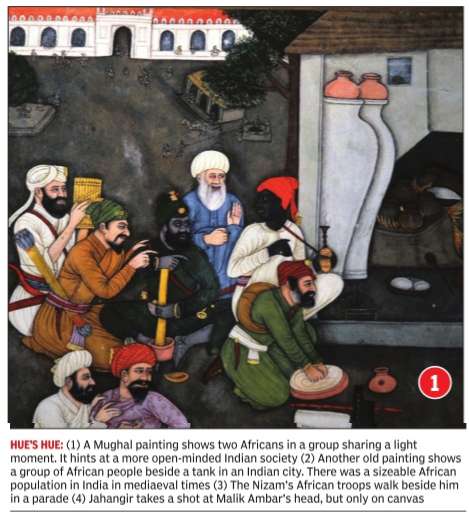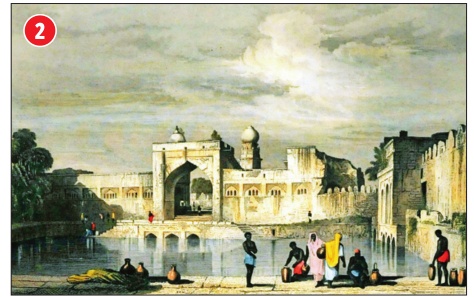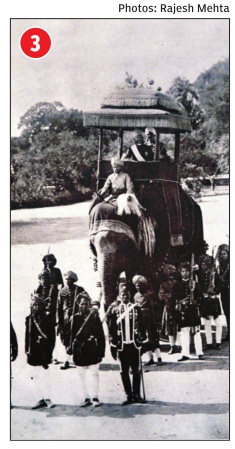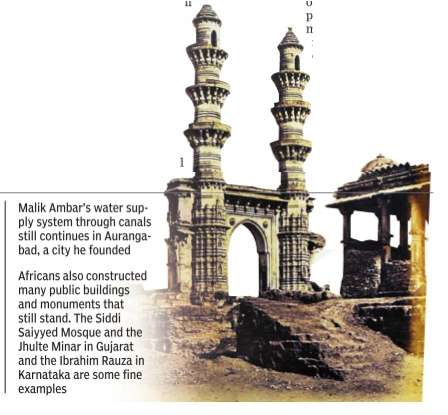Africans in Indian history
This is a collection of articles archived for the excellence of their content. |
WHEN BLACK WAS NO BAR





Manimugdha Sharma The Times of India Oct 10 2014
Arab traders brought them as slaves but once in India, Africans did not face racial discrimination. They could rise in military service or the courts of emperors, and some went on to found dynasties.
Behind the high walls of a lost fortress in what is today south Delhi blossomed the love story of Delhi's first woman ruler and her Abyssinian general.Historians are divided if it was love or just a strong bonding, but popular literature has forever paired Razia Sultan with Jamal-ud-din Yaqut. Yet it was this love or bonding that doomed both. The powerful Turkic nobles in Razia's court loathed the meteoric rise of Yakut from a slave to Amir ul Umara (premier noble). We don't know if he was hated for the colour of his skin, but the Turks pejoratively referred to him as “habshi“ (someone from Al Habsh or Abyssinia, the modern-day Ethiopia) and considered him inferior to them.
There is a Mughal paint ing depicting two Africans in a group sharing a light moment. It hints at a more open-minded Indian society in the mediaeval period. “It amazes us to this day how Indian society was so remarkably open in the past. It didn't distinguish between whites and blacks. The idea behind our exhibition was to showcase this multicoloured picture of India and the contribu tion Africans made towards completing it. We chose the title because the Indian masses today do not know much about the Afro-Indian community . Through these stories people will know that Africans did not come to India yesterday and will get an insight into the rich history of the AfroIndians,“ said Dr Sylviane A Diouf, curator. The journey of Africans to India was itself fascinating: captured by Arab slave traders, they were packed into hell ships that came to India via the Indian Ocean and its surrounding seas. They were bought by kings, princes, rich merchants and aristocrats and were referred to as habshis or Siddis. But not all remained slaves. Some like Yakut made their own destiny .
Malik Kafur, for instance, was a transgender slave bought by Sultan Alauddin Khilji's general Nusrat Khan for a thousand dinars. Kafur caught the fancy of the sultan and rose through the ranks, becoming his deputy and entering history books as Nawab Hazar Dinari. In his last days, an enfeebled Khilji was at the mercy of Kafur who effectively ruled Delhi and also played kingmaker after the sultan's death.
In the Deccan, Africans made a deeper impact on the political landscape. One of the architects of the Deccan's resistance to Mughal expansion was Malik Ambar, an African who served as prime minister and general of Ahmadnagar, one of the offshoots of the Bahmani kingdom.
Ambar is said to be the father of guerrilla warfare in India since he used his Maratha cavalry to harass the Mughals with great effect. Frustrated, Emperor Jahangir nursed extreme hatred for Ambar, and one of the paintings at the exhibition shows him firing arrows at the severed head of Ambar--a fancy he could only realize on canvas.
The Bijapur state had a clique of habshi nobles led by Ikhlas Khan, a powerful general. That the title `Khan' (reserved only for people of high birth at that time) was bestowed upon him shows that Africans could break the glass ceiling.
Some Africans, like the Siddis of Janjira, even set up independent kingdoms. The Siddis commanded Mughal navies and were respected by both Marathas and the European powers. The Janjira state and its successor state of Sachin survived until Independence.
An exhibition called `Africans in India: A Rediscovery' has been put together by Schomburg Center of New York Public Library. It traces the extraordinary achievements of Africans in India since the 1300s.
“India has been a long-time meritocracy. Whatever your background, you could move up the ranks. Nowhere else in the world have Africans been able to rule outside Africa,“ said Dr Kenneth X Robins, curator.